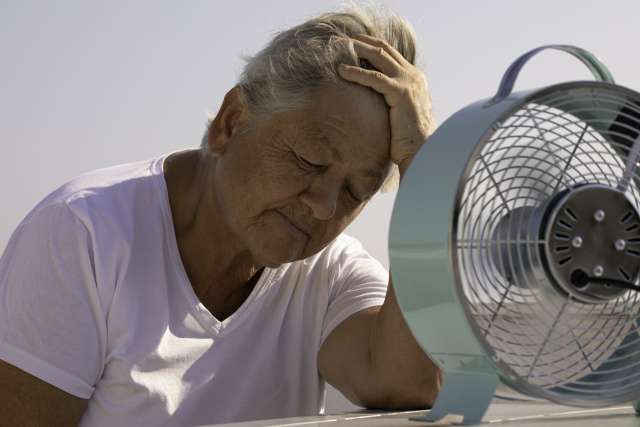Temperatures in the 90s - and in some areas reaching the 100s - throughout Southern California has led the National Weather Service to issue an excessive heat warning through Monday, Sept. 9.
As temperatures rise, so does the risk of heat-related illness.
Public health officials advise caution, especially for older adults, young children, people with chronic medical conditions and people who work outdoors. If possible, avoid going outside during the hottest times of day and be sure to stay hydrated.
“On any day with extreme heat, emergency rooms in Los Angeles see an additional 1,500 patients,” says , a professor at UCLA's David Geffen School of Medicine and the Fielding School of Public Health.
“We estimate that an additional 16 people die on a single day of heat in Los Angeles County,” Dr. Eisenman says. “There are an extra 40 deaths a day by the fifth day of heat.”
These heat illnesses disproportionately affect Black and Hispanic members of the community living in historically redlined neighborhoods, he says, where housing units have less insulation, often lack air-conditioning and there are fewer trees to provide shade.
“Part of the lack of investment was the lack of trees and shade,” Dr. Eisenman says. “These are communities that are several degrees hotter all the time. And on an extreme heat day, they can be 10 or 20 degrees hotter.”
Different kinds of heat illnesses
Heat illnesses and injuries range from heat rash and sunburn to more serious conditions such as heat exhaustion and heat stroke, according to the .
All call for cooling down the affected individual and getting them out of the sun. Heat stroke, however, can be deadly, says Mark Morocco, MD, professor of emergency medicine at the David Geffen School of Medicine at UCLA and attending faculty at the Ronald Reagan UCLA Medical Center Emergency Department.
“That use of the term ‘stroke’ is because you should really think of it as a life-threatening heat illness,” Dr. Morocco says. “Heat stroke is an emergency, a very big emergency, the way a regular brain stroke is. That’s something where you need to immediately react and get your person to somebody who can help them. That means calling 911.”
Heat stroke is when the body’s core temperature exceeds 103 degrees. Such high temperatures “cook” the body at a cellular level, “so proteins stop working and basic body functions begin to break down,” Dr. Morocco says.
Identifying symptoms of heat stroke
People experiencing heat stroke often begin acting strangely, like they are “drunk with heat,” Dr. Morocco says. A person who is dangerously overheating may:
- Seem confused or agitated
- Have trouble walking or talking
- Experience nausea or dizziness
An individual experiencing these symptoms needs immediate cooling and emergency medical attention. Call 911, and while waiting for help to arrive:
- Get the person out of the heat, into shade or an air-conditioned space.
- Loosen or remove tight or constricting clothing.
- Begin cooling the person down however you can. Apply cold, damp towels to their body or spritz them with cold water. If possible, point a fan at dampened skin to create evaporative cooling.
“The thing to remember is we want to reduce the core body temperature as quickly as possible, back down to what sounds like a relatively normal temperature range, where people are used to taking care of fevers,” Dr. Morocco says.
Heat stroke can affect anyone, whether or not they are exercising outdoors in the heat. While exercisers should take particular caution, even sitting in a hot apartment for several days can raise the body’s core temperature to potentially dangerous levels.
Symptoms of heat exhaustion generally appear before heat stroke sets in.
Identifying symptoms of heat exhaustion
People experiencing heat exhaustion don’t exhibit the behavior associated with heat stroke, Dr. Morocco says, but they are likely to:
- Appear overheated
- Sweat profusely
- Have a quick pulse
- Feel tired or weak
- Experience muscle cramps, nausea or vomiting
Individuals experiencing these symptoms need to get out of the heat and into shade or an air-conditioned space, drink non-alcoholic fluids and rest.
People experiencing heat exhaustion will usually recognize they are overheating, Dr. Morocco says. However, those experiencing heat stroke may not, as the condition worsens with continued exposure to heat.
“People can be exposed to increasing levels of heat over a heat wave of a couple of days, or even a week, and slowly get worse and worse and worse,” he says. “It begins with, ‘It’s hot; I feel bad.’ And maybe they have other medical issues or challenges. And then all of a sudden, they slip into this state where they're not able to really recognize quite what's going on with them.”
Take action to prevent serious illness
It’s critically important to check in on loved ones — especially older adults who live alone — during heat waves.
It’s wise to stay out of the sun during the hottest times of the day, if possible. If you exercise outdoors, aim for early morning or late evening. When spending a day at the beach or the park, seek out a shady spot. Remind children to rest periodically and drink water.
And when a heat stroke hits, look for cool places to be inside. If your home lacks air conditioning, consider heading to a mall, a movie theater or a cooling center. Los Angeles County maintains a list of cooling centers at .
“The most important thing for folks to realize is that in hot weather, you've got to check on people who are at risk,” Dr. Morocco says. “That includes the elderly; it includes people who have lots of medical problems; it also includes infants and children.”
If you live in Los Angeles County, visit to find a cooling center near you.





